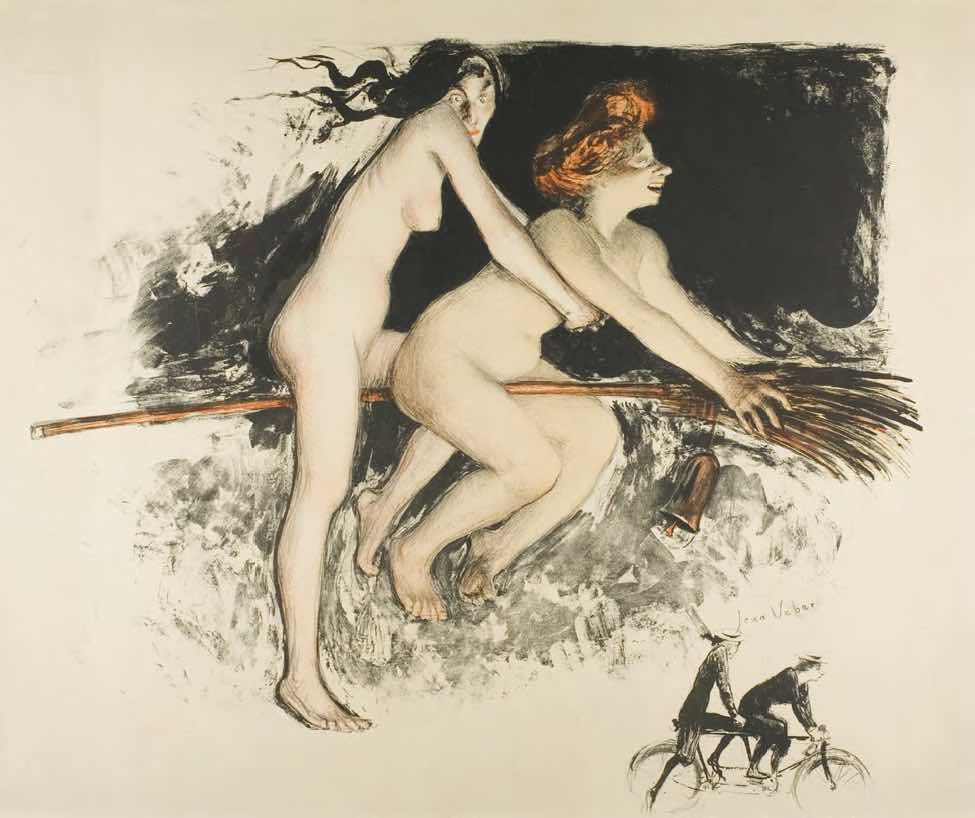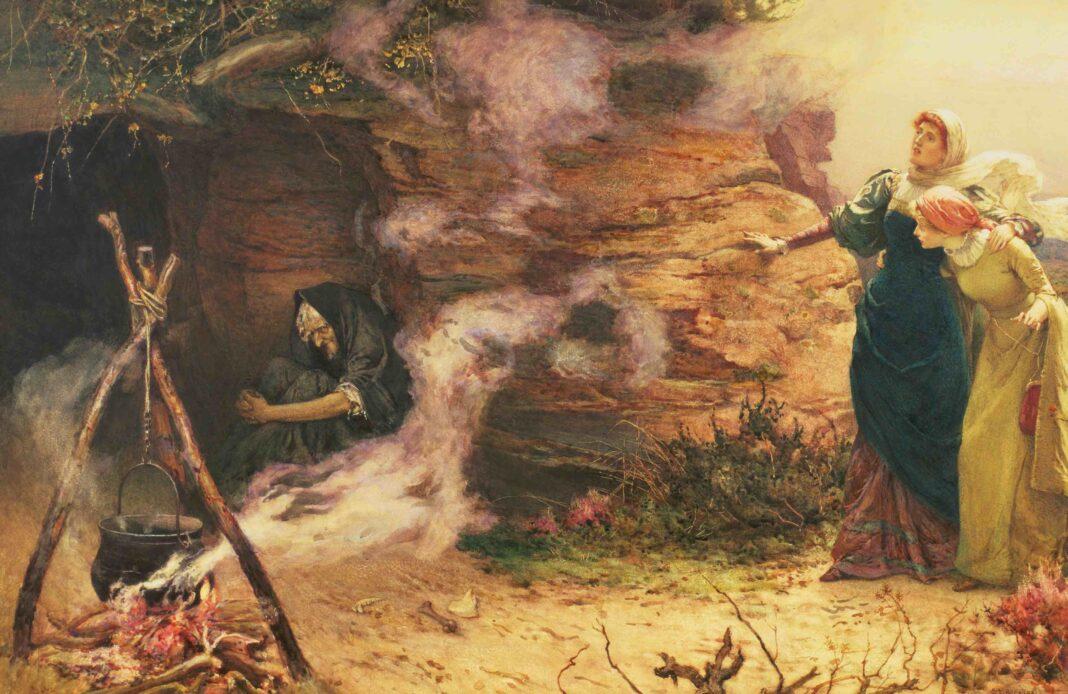For the Victorians, witchcraft was a thing of both fantasy and all too real fact. As late as 1895, there was the terrifying case of Bridget Cleary in Tipperary, Ireland. Believed to be bewitched, she was burned alive by her husband on the evidence that one of her legs was longer than the other—ample proof that she must have been bedeviled. Bridget’s fate was extreme, but more mundane tales regularly peppered the newspapers throughout the later 19th century. Regional papers carried accounts of witchcraft resulting in the killing of livestock, illness in servants, and drying up cow’s milk. That particular spell was supposedly countered by putting a pair of breeches on the cow’s horns, causing it to run toward the house of the witch. Against a backdrop of all these rural accusations and superstitions, it seems odd that painters would choose witches as their glamorous muses, but women and their magical powers have always fascinated male artists. When the spell is cast, however, who has the power and who should be afraid?
You don’t have to search too far in 19th century art to find an archetypal witch. She is the fairy-tale type, the trope of an old crabapple-faced bundle lurking malevolently in a cave and cackling at inappropriate moments. Images like Edward Brewtnall’s 1882 painting Visit to the Witch shows witchcraft as a preserve of the old while young nubile maidens come to visit, flirting with the chance of a bit of magic on their side without having to put in the hard work of gathering herbs and squeezing toads and the like. The beautiful and youthful are merely spell tourists, not yet dedicated to the world of black cats and brooms. The old, wizened witch of art is sexless and amoral, not actively evil but fiddling with the natural order of things. The girls who visit want love potions to ensnare an unwilling suitor, proving to men that women are always up to something when you leave them alone together.
There is a definite difference between a sorceress and a witch in art. John William Waterhouse’s The Magic Circle (1886) shows a young and beautiful creature with overtones of Kate Bush in her long gray-lavender dress and wild hair. She is alluring but to be feared, as she is serious in her craft. Similarly, Frederick Sandys’s Medea (1868) is so intense in her art that she’s in the act of yanking off her coral beads. The significance is that coral protects children, and part of the spell she is casting will kill her errant lover’s children and his new wife. Men are right to fear a sorceress; just look at Merlin and Vivien of Arthurian legend. There was a wizard who was capable of great magic, such awesome power, and he is left ensnared and entangled by Vivien, the beautiful enchantress. A sorceress or an enchantress has definite overtones of sex in their arsenal. Vivien and Medea have that power over men, yet neither use it for merely love. Medea wants to rain death down upon him and Vivien wants Merlin locked away. If a woman has ultimate power, she will not use it to make you love her. She will destroy you, unless you get her first.
Tragically, this was the case for Dorothy Henry, the beautiful young model for artist John Currie, who was obsessed with her. He painted her portrait and, after leaving his wife, vowed to marry her, his muse and torment. His obsession grew deranged, and he painted her again in 1913 as The Witch, in which she combed her hair and smiled in a knowing manner. Dorothy had become Lady Lilith, a Biblical witch and destroyer of men’s dreams, combing her hair in her self-absorbed vanity. No man is enough for these creatures, no man can fulfill the desires they have. Only their own reflection is enough, and that is a frightening thought. Currie, mad with jealousy and anger, shot Dorothy in her Chelsea apartment in 1914. He then shot himself, telling a policeman who found him as he died that he had done it because he loved her. Currie left his wife a letter of explanation, saying that Dorothy had power over him, was ruining him, and he had no choice, even at the expense of his own life. She was twenty years old.
In a climate of such fear, it is unsurprising that artists sought to strip witches of their power by stripping them of their clothes. Among the necklace-clutching sorceresses and wrinkle-cheeked grannies are a swath of naked, nubile, naughty witches astride their broomsticks, some of the most beautiful painted by Luis Ricardo Falero. Twin Stars (1881) is possibly Falero’s best known, if not most notorious, work. It was once boarded up by Scotland Yard’s vice squad for being obscene, but now graces the walls of the Metropolitan Museum in New York. It didn’t take long for Falero to add flying witches to his heavenly bodies, and they were equally as gorgeous. Falero painted witches many times, clutching their broomsticks between plump pink thighs as they hurtle about deep blue night skies. One is even riding side-saddle in The Witches’ Sabbath, her flame-red hair flickering behind her as she holds a torch to light her way. In The Belated Witch, Falero shows us one of the sorcery-sisterhood who has obviously been too busy getting ready to get to the Sabbath on time. For Falero, witches are Titian-haired, like fiery thunderbolts, far more titillating than threatening.

But in 1878, Falero produced the truly epic Witches Going to the Sabbath, a whirlwind of bottoms, boobs, thighs, and the occasional goat. This swirl of naked flesh shows half the witches not even bothering with a broom at all, some hanging on to others. A game old hag is shown grabbing both a goat horn and a younger witch and even a chap with a beard in this equal-opportunity Sabbath. It’s hard to know where to look as there is enough disturbing erotica to satisfy everyone. It is an unusual witch picture that involves men, so what is this hurricane of a Sabbath warning us about? Surely by making the women young and sexy, Falero has given the male gaze the power and made the witch merely an excuse for women to be naked in a picture? There is a playfulness in all of Falero’s nudes, but Witches Going to the Sabbath is different. There is urgency and determination in the journey, and these denizens of the night have gathered as a group, providing strength in numbers. Unlike his other nubile ladies, these witches are not displayed for your pleasure—they have somewhere to be. The witches in this picture have a gathering to attend that is none of your business, and you should be afraid. But what could those naked ladies be up to that could be of concern?
The answer may lie in Jean Veber’s turn-of-the-century picture Witches (1900). Like Falero, Veber’s girls ride naked on a broomstick. One girl has her hair streaming behind, the other has hers piled up in a Gibson Girl–style pouf on the top of her head. These are very Edwardian witches, modern and ridiculous, but below them is a neat little sketch of presumably the same two girls on a tandem bicycle. We are suddenly struck that these witches not only want freedom in the skies; they want freedom over themselves. Susan B. Anthony wrote in 1896: “I rejoice every time I see a woman ride by on a bike. It gives her a feeling of self- reliance and independence the moment she takes her seat; and away she goes, the picture of untrammeled womanhood.”
Witchcraft!
The spell these women Witches (1900), Jean Veber wanted to cast was one of emancipation, and it is no coincidence that the suffragettes embraced the bicycle as their chosen form of transportation, free of male control. Through cycling, they were able to slowly transform their style of dress away from constriction and corsets to gathered trousers and freedom. With the new harem-style pants, you could clearly see that a woman had two legs! She might as well be naked. The bicycle was mostly a vehicle for one, a way for a woman to travel away from the control of
her father, brother, or husband. She could determine her own path, her own destination, and she could go at speed. A woman on a bicycle needs no husband to transport her or decide her destiny. The Suffragette Spinster on her bicycle was the epitome of self-determination and became the poster woman for the new market for bicycle sales to young women. Despite being embraced by capitalism, the lingering distrust of a cycling spinster remained. It’s no coincidence that in the 1939 movie The Wizard of Oz, the frantically peddling Miss Gulch transforms into the Wicked Witch of the West, her bicycle morphing into a broom before Dorothy’s eyes.
The power of the witch lies in her autonomy. The Victorians feared that women would discover freedom was for life and not just for Sabbath, and make off on their tandems or broomsticks, whichever was to hand. I have always wondered about the significance of a witch’s broomstick. Is it meaningful that a woman could use possibly her most important domestic tool, a symbol of labor and servitude, to subvert and deny male power? If women cannot be trusted alone with brooms, what can be done? Even removing their clothes does not make women behave, although it does give us something pretty to look at. Freed of clothing, aboard transport built for one (or shared with a like-minded friend), women move more quickly, bright and fast like comets, finding others that share their beliefs. Together, the witches will gather, will combine their magic.
If I were the patriarchy, I’d be worried—and start watching the skies.



































